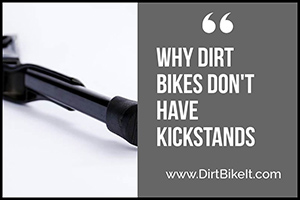How to Downshift on a Dirt Bike Safely With or Without Clutch

How to Downshift on a Dirt Bike Safely With or Without Clutch
In my experience with Dirt Bikes and Dirt Bike racing, I’ve come across riders of all experience levels. A debated topic among newcomers and experienced riders alike is whether or not you need to use the clutch when downshifting on a dirt bike.
You don’t, but it wouldn’t hurt. A number of riders I’ve encountered have been on bikes longer than I have and have never once used their clutch when down shifting.
Others always use the clutch when downshifting on their dirt bike.
I’m writing this article in hopes that it can give new dirt bike riders a comprehensive overview of downshifting on a dirt bike, and so that experienced riders can find some more information about whether or not it is necessary to use the clutch when downshifting on a dirt bike.
When do you shift on a dirt bike?
For new riders experienced in driving with a manual transmission car or motorcycle, downshifting should come pretty naturally to them. For those riders who have never had to shift in their life, there may be a bit of a learning curve.
To keep it as basic as possible, you shift “up”, or to higher gears, when you need to go faster but the bike isn’t accelerating with the throttle. At this point, you should see a high amount of RPMs and feel the engine working, but with no real result in acceleration. This is when you want to shift up.
Conversely, you want to downshift on your dirt bike as you gradually decrease your speed.
To shift, you’ll pull the clutch bar on the left side of the handlebars and use your left foot to move the “stick shift” of the bike, which is on the left side. The stick shift will be just in front of the boot peg on the left side of the bike. To get into first, you’ll need to press down with your boot, and then to shift into higher gears, you’ll push the shifter up with your boot.
Then, when you downshift, you push the shifter down with your boot.
As I mentioned in my introduction, the clutch isn’t entirely necessary when downshifting a dirt bike. When shifting up into higher gears, the throttle and engine will be putting torque, or a twisting force, and pressure on the gears. This makes it necessary to release the pressure using a clutch, so you don’t damage your engine.
What is a Clutch on a Dirt Bike?
Just as in a manual transmission car, the gas and brakes are together on the right and the clutch is set off on the left. The clutch lever on a dirt bike will be on the left hand side of the handlebars, and resemble the brake bar on the right.
I don’t want to intimidate any novices with a full lesson in engine mechanics. For the sake of keeping it simple, I’ll say that a clutch is a connection between the always-rotating engine and the sometimes-rotating gears and tires.
If you want the engine to rotate faster, you give it gas, but the individual gears can each only rotate so fast. When the engine is rotating, it puts pressure and torque on the gears. If you shifted with this torque, you’d grind away at the metal. So you have two solid parts of a machine connected by the clutch, with one putting torque on the other.
Essentially, the bar on the left side of your handlebars is a clutch release lever that allows you to sever the connection between the engine and gears. Pulling the clutch bar releases the connection and you can shift to a new gear without two solids grinding away at each other.
A key difference to remember when comparing dirt bike engines and car engines is the fact that a dirt bike engine will be more well-oiled and multi plated. This means that even when you grind gears when shifting up on a dirt bike, the damage and wear you cause to the bike will be much less severe that what you’d see in a manual transmission vehicle.
Why Don’t You Need to Use the Clutch When you Downshift on a Dirt Bike?
One of the main reasons that it isn’t necessary to use a clutch to downshift on a dirt bike is because and torque will be going in the opposite direction and there isn’t a lot of pressure in the system that could cause grinding and wear. Additionally, compared with a car, a bike’s engine will be much more well oiled and have multi plated parts.
As a result of these differences, it’s not necessary to use the clutch every time you down shift. Even when shifting to higher gears, the wear caused from not using a clutch every time will be minimal when compared with what would happen if you did the same in a car.
A lot of riders never use the clutch when downshifting on their dirt bikes. Some riders even never or barely use the clutch when shifting up on their bikes.
Is it harmful to not use the clutch when down shifting on a dirt bike?
When you shift up into a higher gear on a dirt bike, there is a lot of torque and pressure on the engine and the gears. That’s why you’re shifting up!
The torque on the gears when you upshift is what will cause any damage if you’re not releasing the pressure with the clutch. When you’re downshifting, there won’t be any real torque or pressure in the directing that you’re shifting gears, so it is less necessary to pull the clutch.
Simply put, because the throttle isn’t revved when you’re downshifting on a dirt bike, there isn’t any real pressure on the gears, so the wear you could cause is minimal.
It’s important to remember though, that even when shifting up into a higher gear, the damage that you might cause is minimal when compared with what could happen if you did the same in a car.
How Do You Put a Dirt Bike Back Into Neutral?
One of the key elements with shifting gears (Up or Down) on a dirt bike or any machine with a manual transmission is getting a feel for it over time. Once you’ve been on a bike for a while, you’ll now exactly what each gear feels like by the speed of your bike and how much the engine is working.
One of the first things that are important for new riders to understand is how neutral “feels”.
Once you’re ready to stop riding and step off the bike, you’ll need to take it from first gear to neutral. This is easy, but it’s less intuitive than down shifting. When downshifting, you were just pushing the shift pedal down with your foot. When you want to slide your dirt bike into neutral, you’ll need to shift up from first gear, but only slightly.
If you go to far, you’ll put the bike into second. This is why it’s important to understand what each gear on your bike feels like and what neutral feels like.




